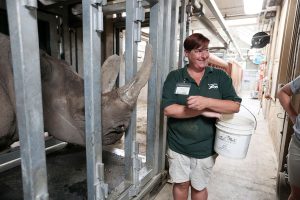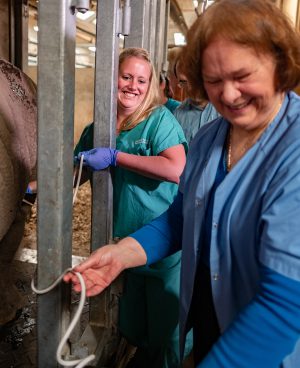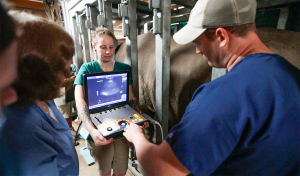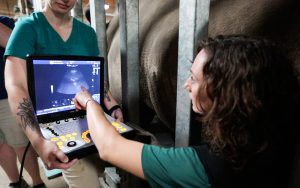
Doppsee, the pregnant black rhino from Potter Park Zoo, is expecting her first calf, and its birth is quickly approaching (Doppsee’s estimated delivery date is for the end of this month, December 2019!). As the veterinary healthcare team and zookeepers at Potter Park Zoo and the veterinarians from the Michigan State University College of Veterinary Medicine prepare for the delivery, they're reminded of where this journey began and why it’s so significant—not just for Potter Park Zoo and the College, but for Doppsee and the critically endangered black rhino population.
Doppsee and her unborn calf—are members of the Zoo family—and now the MSU family as well. Making sure Doppsee and her calf are healthy is of the utmost importance—not just because they are part of the Species Survival Plan for the Association of Zoos and Aquariums, but to increase the likelihood of preserving the black rhino species by spreading their genetics.

To protect the health of Doppsee and her future calf, Dr. Ronan Eustace, director of Animal Health for Potter Park Zoo and adjunct professor at the College, and visiting Spartan veterinarians and veterinary medical students, have monitored this expectant mom closely throughout her pregnancy. The veterinary department at Potter Park Zoo has a long history of collaboration with veterinary students and residents from MSU, which allows them to learn about zoo medicine.
One Spartan who’s benefited a great deal from this partnership is Dr. Julie Strachota of the MSU College of Veterinary Medicine. Strachota is a clinical instructor for the Department of Large Animal Clinical Sciences and a theriogenology resident. Theriogenology is the branch of veterinary medicine concerned with reproduction. Strachota has been able to learn what it’s like to be an obstetrician-gynecologist (OBGYN) for Doppsee, under the guidance and support of Eustace and Dr. Carla Carleton, professor emeritus of the College.
“Being a part of the veterinary team that ultrasounds Doppsee has allowed us to compare what we see with her pregnancy to more common species, like equids. For me, I’ve been able to show students, Zoo staff, and visitors what we see on the ultrasound,” says Strachota. “For the keepers, their excitement with this pregnancy beams from their eyes. They have such a wonderful, strong bond with Doppsee that I enjoy seeing every time I visit her.”

With assistance from zookeepers, Eustace and Strachota have been able to conduct transabdominal and transrectal ultrasounds on Doppsee throughout her pregnancy. “Earlier in her pregnancy, we were only able to see she was pregnant via a transrectal approach because her uterus wasn’t large enough to see from her flank region. Now, as we are in the last weeks of her pregnancy, we can see the fetus very clearly through a transabdominal ultrasound,” says Strachota.
How does one perform an ultrasound examination on a pregnant rhino? Via constant and committed training by the zookeepers. “Using only positive reinforcement—in the form of her favorite foods—we’ve been able to train Doppsee for abdominal and rectal ultrasounds, blood draws, and exams,” says Eustace. By voluntarily walking in or out of a chute, Doppsee gets to choose whether she wants to participate in every examination, blood draw, and ultrasound. She’s quite the patient.

Veterinarians look for similar things in a rhino pregnancy as human doctors would in a human pregnancy. When they perform an ultrasound on Doppsee, her veterinary healthcare team looks for fetal movement and position, fetal heart rate, and health of the amniotic fluid of the pregnancy. Strachota’s knowledge of animal reproduction is a strong asset for Doppsee’s pregnancy. “One of the things that I have learned about Doppsee’s pregnancy is how you can apply what you know from other species to her. Her placenta is like a horse’s, and what we are monitoring on ultrasound are the same things that we would be doing in a broodmare,” says Strachota.
Though it isn’t always the same, theriogenology is translational from species to species. While learning about rhino theriogenology through her own hands-on experience, Strachota can expose the College’s students to this same knowledge. “I want them to learn how to apply what they know about one species to another that they aren’t familiar with, like Doppsee,” says Strachota. “And I hope that by meeting her, they can appreciate the value that species conservation has in our profession.”

At the College, students are exposed to more hands-on learning. From the clinical skills lab and junior surgery course to internships at the Zoo and other locations, future veterinary professionals are taught to apply their knowledge in real-world situations every day. For some, this includes working with a rhino. “The experience for our veterinary students and faculty is priceless. For most students, they would have never imagined that they would have the opportunity to ultrasound, let alone touch, a black rhino,” says Strachota.
Fortunately for the College's students, this isn't the first time, nor will it be the last, that they’ll have the opportunity to gain hands-on experience with the animals at Potter Park Zoo. As an adjunct professor for the College and advisor for MSU’s Zoo, Wildlife, and Exotics Club, Eustace graciously welcomes and shares his expertise. “Collaborating with Potter Park Zoo is a wonderful educational experience for our veterinary students and faculty,” says Strachota. “Dr. Eustace welcomes as many students as we can bring to work with the animals."
“Today, one of the senior students that I brought with me when I went to examine Doppsee commented that this was ‘the best day of veterinary school.’ What Potter Park Zoo is doing for our veterinary curriculum is invaluable!” Strachota continues. “Students get to learn about animal conservation, zoo medicine, and animal behavior from a variety of exotic species all in one visit. I look forward to furthering my education through continued collaboration with Dr. Eustace and other species at the Zoo.”



